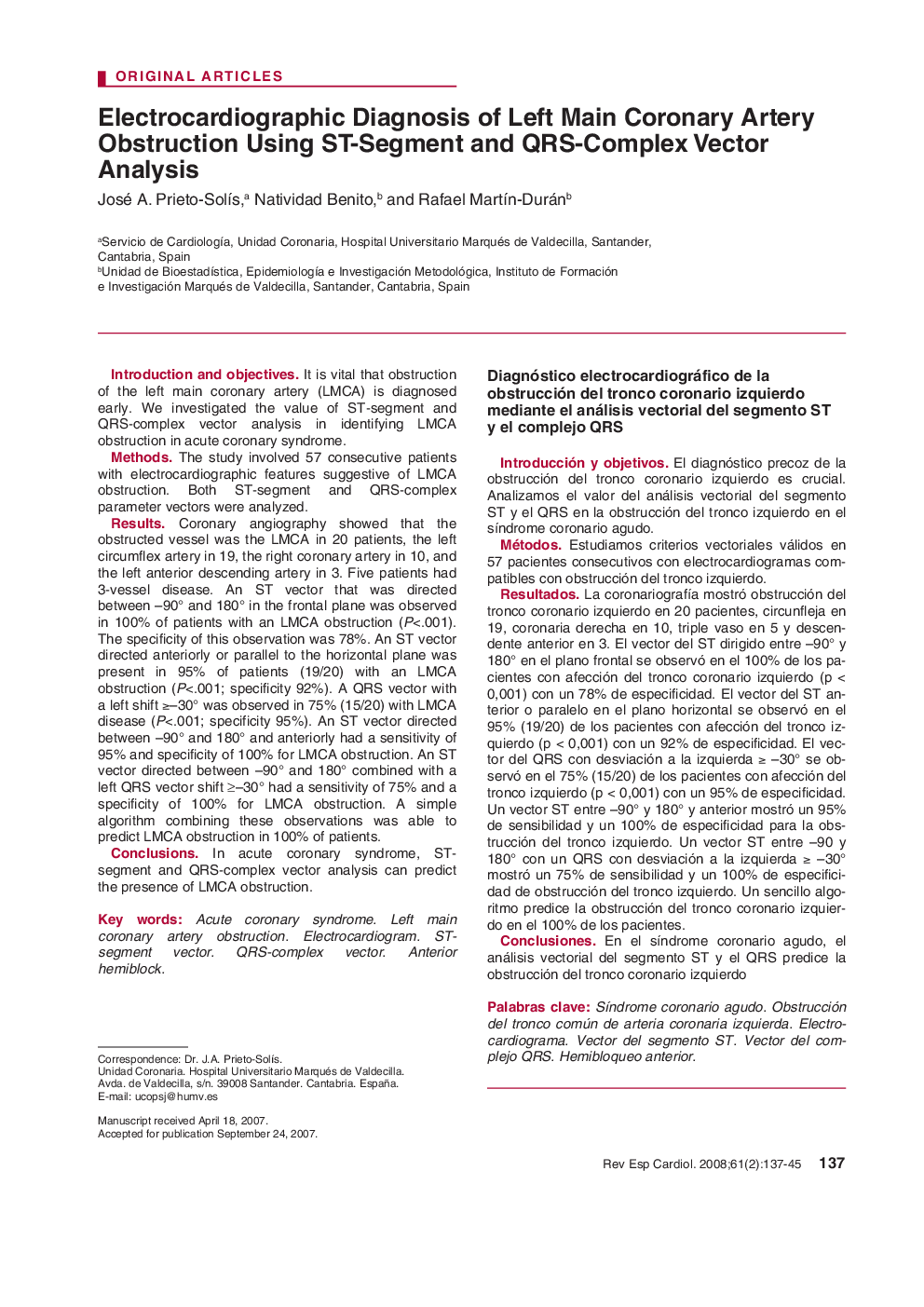| Article ID | Journal | Published Year | Pages | File Type |
|---|---|---|---|---|
| 3018960 | Revista Española de Cardiología (English Edition) | 2008 | 9 Pages |
Introduction and objectivesIt is vital that obstruction of the left main coronary artery (LMCA) is diagnosed early. We investigated the value of ST-segment and QRS-complex vector analysis in identifying LMCA obstruction in acute coronary syndrome.MethodsThe study involved 57 consecutive patients with electrocardiographic features suggestive of LMCA obstruction. Both ST-segment and QRS-complex parameter vectors were analyzed.ResultsCoronary angiography showed that the obstructed vessel was the LMCA in 20 patients, the left circumflex artery in 19, the right coronary artery in 10, and the left anterior descending artery in 3. Five patients had 3-vessel disease. An ST vector that was directed between –90° and 180° in the frontal plane was observed in 100% of patients with an LMCA obstruction (P<.001). The specificity of this observation was 78%. An ST vector directed anteriorly or parallel to the horizontal plane was present in 95% of patients (19/20) with an LMCA obstruction (P<.001; specificity 92%). A QRS vector with a left shift ≥–30° was observed in 75% (15/20) with LMCA disease (P<.001; specificity 95%). An ST vector directed between –90° and 180° and anteriorly had a sensitivity of 95% and specificity of 100% for LMCA obstruction. An ST vector directed between –90° and 180° combined with a left QRS vector shift ≥–30° had a sensitivity of 75% and a specificity of 100% for LMCA obstruction. A simple algorithm combining these observations was able to predict LMCA obstruction in 100% of patients.ConclusionsIn acute coronary syndrome, ST-segment and QRS-complex vector analysis can predict the presence of LMCA obstruction.
Introducción y objetivosEl diagnóstico precoz de la obstrucción del tronco coronario izquierdo es crucial. Analizamos el valor del análisis vectorial del segmento ST y el QRS en la obstrucción del tronco izquierdo en el síndrome coronario agudo.MétodosEstudiamos criterios vectoriales válidos en 57 pacientes consecutivos con electrocardiogramas com-patibles con obstrucción del tronco izquierdo.ResultadosLa coronariografía mostró obstrucción del tronco coronario izquierdo en 20 pacientes, circunfleja en 19, coronaria derecha en 10, triple vaso en 5 y descen-dente anterior en 3. El vector del ST dirigido entre –90° y 180° en el plano frontal se observó en el 100% de los pa-cientes con afección del tronco coronario izquierdo (p < 0,001) con un 78% de especificidad. El vector del ST an-terior o paralelo en el plano horizontal se observó en el 95% (19/20) de los pacientes con afección del tronco iz-quierdo (p < 0,001) con un 92% de especificidad. El vec-tor del QRS con desviación a la izquierda ≥–30° se ob-servó en el 75% (15/20) de los pacientes con afección del tronco izquierdo (p < 0,001) con un 95% de especificidad. Un vector ST entre –90° y 180° y anterior mostró un 95% de sensibilidad y un 100% de especificidad para la obs-trucción del tronco izquierdo. Un vector ST entre –90 y 180° con un QRS con desviación a la izquierda ≥–30° mostró un 75% de sensibilidad y un 100% de especifici-dad de obstrucción del tronco izquierdo. Un sencillo algo-ritmo predice la obstrucción del tronco coronario izquier-do en el 100% de los pacientes.ConclusionesEn el síndrome coronario agudo, el análisis vectorial del segmento ST y el QRS predice la obstrucción del tronco coronario izquierdo
